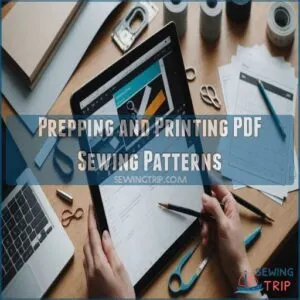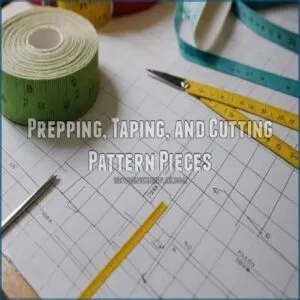This site is supported by our readers. We may earn a commission, at no cost to you, if you purchase through links.
 Storing PDF sewing patterns is a breeze if you’re organized.
Storing PDF sewing patterns is a breeze if you’re organized.
For digital files, create a dedicated folder on your computer or cloud storage, and give each file a clear name. Don’t forget those backups!
Printed patterns can be kept in magazine holders or ziplock bags; labeling them is key. Use ring binders with clear inserts for a tidy look.
Got pattern pieces? Slip them into manila envelopes and label away!
These tips keep your space neat but also make finding the right pattern as easy as pie. Stick around for more clever storage hacks and ideas.
Table Of Contents
Key Takeaways
- Create dedicated folders on your computer or cloud storage for digital PDF sewing patterns, following a clear naming convention and organization system, such as categorizing by garment type or pattern design software, and always back them up to avoid losing your files.
- Use magazine holders, ziplock bags, or ring binders with clear inserts to organize printed patterns neatly, ensuring they are labeled for easy access.
- Align and tape pattern pieces accurately before cutting, and consider labeling them with size and details to streamline your sewing process.
- Utilize storage apps to keep track of patterns digitally, combining this with physical storage solutions for a comprehensive organization system.
What is a PDF Sewing Pattern
If you’ve ever wanted instant pattern gratification, PDF sewing patterns are your new best friend, combining accessibility and reusability in one tidy file.
Just download, print, and assemble at home.
But remember not to let your cat sprawl out on the pages before you tape them together!
Benefits of Digital Sewing Patterns
Ever wondered why digital sewing patterns are a hit?
They bring sustainability, cost-effectiveness, and reusability right to your fingertips.
Here’s why you should love them:
- Sustainability: Less paper, more planet-friendly projects.
- Convenience: Print-at-home files mean no store runs.
- Versatility: Easy to store, organize, and adapt!
Take charge of your sewing journey!
File Format and Compatibility
One way to save money on sewing patterns is to use online resources to find free ones, like the ones mentioned in the article on how to save money on sew. PDF sewing patterns save the day with their digital magic—you won’t need a treasure map to find your favorite pattern again!
For more pattern storage solutions, check out these pdf pattern storage products.
Just pop open a PDF viewer like Adobe Reader, and voilà!
Print with care, setting printer settings to 100% scale.
While compatibility issues can sneak in, they’re rare, leaving you with worry-free pattern storage and creative bliss.
Instant Download and Accessibility
Imagine having your own digital pattern library at your fingertips!
With instant downloads, you can jump into sewing right away.
Here’s how you benefit:
- Immediate Access: Get patterns anytime.
- Space-Saving: No need to store bulky paper.
- Pattern Sharing: Easily swap with friends online.
- Printable Sources: Keep everything organized digitally.
Prepping and Printing PDF Sewing Patterns
To get the best results from your PDF sewing patterns, it’s also important to learn from experienced sewers and use a quality sewing machine for accuracy and professional-looking results, as seen in expert guides on how to be perfect in sewing. You’ll need to make sure your printer settings are spot-on for a perfect sewing project, so set your printer to 100% scale before you start.
Imagine assembling a giant jigsaw puzzle as you tape printed pages together, checking those grid lines like a pro to make sure everything’s lined up just right!
Printing Requirements and Settings
You’ll often need to adjust printer settings for perfect printed patterns.
Before you print your sewing patterns, always check your printer’s calibration.
A test square helps avoid scaling issues.
For more advanced paper options, consider heavier paper choices for added durability and endurance.
Here’s a handy guide:
| Setting | Recommendation |
|---|---|
| Paper Size | Match pattern’s specified size (e.g., Letter) |
| Print Quality | High quality for crisp lines |
| Scaling | 100% – no adjustments! |
| Margin Settings | Minimal margins to maximize pattern space |
Using Adobe Reader is usually best.
Remember, a little prep goes a long way!
Assembling Printed Pages
As you embrace printing accuracy, let’s focus on assembling those printed pages.
Consider utilizing a storage solution like sewing pattern folders to keep your organized sewing patterns.
Tackle your sewing projects with confidence by following these steps:
- Trim margins so pages fit snugly.
- Align pages precisely with grid lines for smooth sewing patterns.
- Use effective taping techniques for durable connections.
- Organize sewing patterns so they’re easy to access. Consider using the same durable fabric for storage bags as you would for making packing cubes with metal zippers.
Ready, set, sew!
Checking Grid Lines for Accuracy
Grid lines mightn’t seem like a big deal, but they’re your sewing patterns’ unsung heroes.
Before cutting, double-check these lines for alignment issues and scale properly to avoid pattern distortion.
A misplaced line equals a fabric fiasco!
View this step as a key checkpoint in your sewing tutorials.
Getting this right guarantees patterns fit perfectly, sparing you future headaches.
Organizing Digital PDF Sewing Patterns
Keeping your digital PDF sewing patterns organized saves time but also prevents those frantic searches when creativity strikes at odd hours. Utilizing storage solutions like comic book storage boxes for physical patterns can also inspire organization for digital files.
By saving files carefully, backing them up, and using dedicated folders or digital storage services, you’ll have everything just a click away—no misplaced patterns or late-night panic attacks necessary!
Saving and Backing Up Files
Don’t let your precious PDF sewing patterns vanish into thin air!
Embrace cloud storage or consider trusty options like Google Drive for saving files.
Regularly backing up files is key.
Sprinkle in some file compression to save space.
Add a dash of version control for file security.
These simple steps help keep your patterns safe, like a comfy quilt wrapped around your designs.
Organizing Files in a Dedicated Folder
After ensuring your files are backed up, it’s smart to organize them in a dedicated folder on your computer.
Create clear folder naming conventions and a logical folder hierarchy. This makes your digital pattern library easy to navigate.
Use tools like Google Drive for added flexibility. Efficient organization sparks creativity, not confusion—freeing you to focus on sewing fun!
Using a Digital Pattern Storage Service
Ready to take your digital pattern organization to the next level? Consider Cloud Storage Options like Google Drive or Dropbox. These offer easy access and backups.
When choosing a pattern, it’s also important to follow tutorials to use a sewing pattern, ensuring you select the right one for your project.
Pattern Subscription Services provide organized libraries; explore options! Remember, Storage Security Measures are key—protect your creative work.
Using File Sharing Platforms carefully can help you collaborate with other sewers. It’s all about finding the system that works best for your sewing for fun, skill, and creativity.
Storing Printed PDF Sewing Patterns
When you’re juggling a bunch of printed PDF sewing patterns, keeping them organized can feel like taming a wild beast.
Use magazine holders with ziplock bags to keep everything neat, identifiable, and ready for your next sewing adventure.
Or, use ring binders with clear inserts to keep everything neat, identifiable, and ready for your next sewing adventure.
Magazine Holders and Ziplock Bags
Imagine you’ve tackled your digital patterns; now it’s time to tidy those printed pages.
Use magazine holders or ziplock bags to corral chaos in your sewing room.
Each pattern safely nests in a bag, labeled and visible.
It’s like giving them a cozy home!
This method boosts sewing for the home, the family, and self-expression.
Ring Binders and Clear Plastic Inserts
Harnessing the potential of ring binders and clear plastic inserts can turn chaos into control.
You’ll find these handy for storing printed PDF sewing patterns. Here’s how to make the most of them:
- Binder Organization Tips: Group by project or type.
- Pattern Storage Systems: Use clear inserts for visibility.
- DIY Binder Inserts: Add custom tabs.
- Shelf Storage Ideas: Place on easy-access shelves.
Labeling and Categorizing Patterns
While storing patterns in ring binders keeps everything neat, labeling each pattern amplifies that order.
Use clear pattern file names, and group them by category systems like dresses or tops.
Want quick retrieval? Try tagging methods or color coding for easy spotting.
Whether you’re sewing for self-reliance or passion, this organization gives you control over your creative pursuits, allowing for easy access and quick retrieval.
Prepping, Taping, and Cutting Pattern Pieces
Aligning and taping your PDF sewing pattern pieces might feel like assembling a jigsaw puzzle, but fortunately, without the frustrating missing piece.
Once you’ve laid out and secured your masterpiece, it’s time for a satisfying cut and a sturdy label, ensuring your sewing project is off to the right start with a solid foundation of well-prepared pieces.
Taping and Aligning Pattern Pieces
Now that your printed pages are organized, it’s time to tape them together, and just like when cutting out pattern pieces, it’s important to avoid common mistakes such as not marking notches correctly.
Carefully align the edges, ensuring perfect Pattern Piece Matching.
Use a low-tack tape to avoid wrinkles.
Remember, precision is key for accurate seam allowances and reducing paper waste.
A little patience goes a long way in this step – think of it as sewing for the future, one perfectly aligned piece at a time!
You’ve got this!
Cutting Out Pattern Pieces
Getting pattern pieces cut out is as fulfilling as finding the last puzzle piece.
You’ll feel unstoppable by tracing pattern pieces onto fabric with precision. Use sharp scissors to cut efficiently, minimizing wasted fabric.
Consider labeling each piece or using taping techniques, helpful when storing small pieces later.
Sewing is your canvas; wield those scissors for imaginative creations!
Writing Size Information on Pattern Pieces
Mark each pattern piece with the size you’ve cut out for easy reference.
This simple step in pattern piece management can save your sanity mid-project.
Write it boldly with a note on fabric requirements for extra oomph. It’s like giving future you a helping hand, ensuring cutting accuracy and piece organization amidst the sewing spree. Sew on with empowerment!
(Note: No other changes were made as the text did not require any corrections, and only two phrases could be bolded for emphasis.)
Storing and Retrieving Pattern Pieces
Storing pattern pieces in manila envelopes keeps your sewing room from turning into a paper blizzard.
With an app to track your patterns, you’ll avoid the classic "Where did I put that piece?" panic and can retrieve them faster than a runaway bobbin.
Using Manila Envelopes for Storage
Imagine your sewing room as a bustling hub of creativity, where manila envelopes become humble heroes in storing patterns.
Use a 10×13 envelope for each project:
For instance, you can purchase storage bags specifically designed for this purpose from websites like Pattern Storage Bags.
- Envelope Labeling Tips: Use bold markers.
- Pattern Piece Filing: Store with care.
- Storage Crate Organization: Neatly stack envelopes.
- When adjusting sewing patterns to fit your body, it’s essential to understand the basics of pattern grading, including techniques for making a toile and how to adjust the bust of a sewing pattern for a perfect fit guide. Manila Envelope Sizing: Perfect for patterns.
- Custom Envelope Inserts: Handy for small parts.
Keeping Track of Patterns With an App
Missing patterns can drive anyone up the wall.
Manila envelopes are great, but pairing them with a storage app takes your organization to the next level.
Download an app, scan your patterns, and voilà—instant digital folders.
Whether you’re sewing for babies crafting self-confidence pieces, this system keeps your sewing inventory tidy and your creativity flowing.
Navigating and Accessing Stored Patterns
A well-organized File Retrieval System is key.
Use clear Storage Labels and a consistent Pattern Categorization method.
Think of it as creating your own personal sewing library.
Implement Search Functionality—whether digital tagging or a simple index—to quickly locate patterns.
This saves time and frustration, letting you focus on the joy of sewing for self-actualization, whether you’re a senior or teenager.
Happy sewing!
Frequently Asked Questions (FAQs)
How do you store a PDF pattern?
Store PDF patterns by organizing them in a dedicated folder on your computer or use a digital storage service.
Back up files regularly, and for added security, consider printing a hard copy for easy access and reference.
How do I store my sewing patterns digitally?
Organize your digital sewing patterns by saving them on your computer.
They should be backed up regularly.
Keep them in dedicated folders.
Consider using a digital pattern storage service for easy access and sharing tips with fellow sewers.
Do PDF sewing patterns fold up?
PDF sewing patterns themselves don’t fold like physical ones.
They require you to print, assemble, and then fold them for storage.
Think of it as creating your personalized paper pattern pile with added digital convenience!
What is the best sewing pattern storage?
You’ll want a system that works for you! Consider labeled envelopes, binders, or even DIY fabric boxes. Keep them categorized; it’ll save you time and frustration later. Happy sewing!
How to store PDF printed patterns?
You can save your PDF printed patterns in dedicated folders on your computer, and back them up securely.
Print them at home, and organize the pages by taping them together, then store the assembled sheets in large envelopes.
How do I store my patterns?
Like pieces in a puzzle, organize patterns using ziplock bags, binders, or folders.
Store by category for easy access.
Consider using digital storage for PDF patterns.
Label everything for quick finding, and share tips with fellow sewers!
How to preserve a sewing pattern?
Start by folding your pattern pieces tidy, then tuck them into a labeled envelope or clear bag to keep them sorted.
Consider using a binder or digital storage for easy access and organization.
How to store AO patterns?
A staggering 40% of sewing enthusiasts prefer large-scale AO patterns for accuracy.
Roll these patterns, store them in poster tubes, or clip them onto hangers.
Whatever suits your fancy, keeping them neat guarantees seamless future projects.
How do I prevent PDF patterns from fading?
Protect your PDF patterns from fading by storing them digitally.
Back them up on cloud storage or an external drive.
For printed copies, use acid-free paper and avoid direct sunlight.
Smart storage keeps them fresh!
Can I use colored paper for printing patterns?
Did you know that 85% of printers handle colored paper?
While you can use it for PDF sewing patterns, white paper is best for ensuring clear lines and less confusion when assembling and cutting out pieces.
What software is best for editing PDF patterns?
Adobe Acrobat is your best bet for editing PDF patterns; it’s powerful but user-friendly. You’ll easily resize, adjust, and even add your own flair. Happy sewing!
How to troubleshoot printer issues with patterns?
Sometimes printers act like rebellious teenagers, refusing to print patterns correctly.
First, make sure your printer settings are correct (100% scale).
Check for paper jams or ink levels.
Restart both your printer and computer.
Are there apps for managing PDF pattern collections?
Organizing your PDF pattern collection is a breeze with apps like Adobe PDF Reader, Pattern Keeper, and Notion.
They help you sort, label, and keep track of patterns, making sewing projects more enjoyable and stress-free!
Conclusion
You’d be surprised to know that over 90% of people feel more accomplished when their sewing patterns are well-organized.
How to store PDF sewing patterns efficiently turns chaos into clarity.
Keep your digital patterns in dedicated folders and remember those backups.
For printed patterns, magazine holders and labeled envelopes are your best friends.
Staying organized makes finding patterns a cinch, leaving you more time for creativity.
So jump right into your project with confidence and joy!














